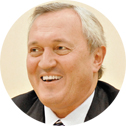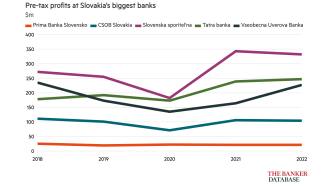
Away from the economic hubs of Moscow and St Petersburg or the oil-rich oblasts, many of Russia's regions suffer much higher poverty and have not attracted the investment necessary to alleviate such problems. In a country of more than 1000 banks, many of the weakest players are based in these regions, and they have been hard hit by the global liquidity squeeze, further delaying economic convergence.
The Southern Federal District (SFD), home to 16% of Russia's population, is a case in point. A United Nations Development Program report published in 2007 estimated incomes and investment per capita for the SFD at half the national average, and unemployment rates double the average.
Professor Vasily Vysokov, chairman of Bank Center-Invest, believes he has some solutions to weathering the storm. Headquartered in Rostov, the region's most populous city, the bank has a 4% share of assets and deposits in the SFD (as of January 2009), and is the largest regional bank in the area, with a 30.5% share of assets held by regional banks in the SFD and a 23.5% share of deposits. "We use the experience of 1998," says Mr Vysokov. "After that crisis, almost all banks had shut down in this region, except for Center-Invest and Sberbank. This time, we saw the crisis earlier than the government. It began taking measures in September 2008; we had already begun preparing from September 2007."
Focus on funding
The bank ensured adequate capital and funding levels, helped by investment from official institutions such as the European Bank for Reconstruction and Development, the International Finance Corporation and Dutch state development fund FMO. "We took money from all our shareholders, such as subordinated debt and long-term loans for onlending to agribusiness and for energy efficiency projects. We reopened the syndicated loan market with a $60m loan in October 2008. All our bond obligations are in Russian roubles," says Mr Vysokov.
According to Semyon Isakov, analyst at Moody's Investors Service, the bank had become more dependent on wholesale funding in 2007, with its loan-to-deposit ratio rising from 120% at the end of 2006 to 160% in the first quarter of 2008. However, retail deposits account for 65% of the total, giving it "one of the lowest single-party deposit concentration levels among CIS banks", he adds.
Center-Invest is seeking to attract further deposit financing, by introducing a higher 'loyalty rate' on accounts for longstanding customers, for example. "We know about the risk of panic, so we kept cash in all the branches, and used our network of 150 cash machines to make sure there are services 24 hours a day. Because our clients know they can get money out, there has been no deposit outflow, in fact we win clients from other banks who shut their doors," says Mr Vysokov.
New approaches to credit
As the Russian economy entered recession in the last quarter of 2008, attention has switched from funding questions to the quality of loan portfolios. Rating agencies noted Center-Invest's concentration in agribusiness – the SFD accounts for about 23% of total Russian agricultural output. However, Mr Vysokov says this concentration is manageable, as the bank's deep roots in the region give it special insight into its clients. "If you make a three-year loan, perhaps there are bad harvests for two years. But if you make a five-year loan, you will have some better harvests and the client has more chance to repay," he says. Only 7% of the bank's business clients have asked for debt rescheduling or restructuring as of December 2008.
Center-Invest's speciality in small and medium-sized enterprises (SMEs) also mitigates concentration risk, with 33,000 separate SME clients accounting for 44% of the total loan portfolio. The bank has focused on energy efficiency as a way to bring down clients' costs. A project to finance the upgrade of a boiler house for the Taganrog heating company cut running costs by two-thirds and the model is being repeated across the client's assets.
However, Mr Isakov says the rapid expansion of Center-Invest's mortgage and auto loans portfolios has created new assets that have not been tested in a serious economic downturn. He was concerned that the bank's non-performing loan (NPL) provisioning even decreased in 2007, to 2.28% of the total portfolio (actual NPLs were at 2.59%). The bank's accounts for June 2008 suggest the provisioning rate has now been increased to more than 3%.
Mr Vysokov believes the bank's energy efficiency drive is just part of a new model that needs to develop what he calls "sustainable banking", where each bank pays greater attention to the success and good governance of its clients. He also draws inspiration from the Islamic finance model of shared risks and rewards. This improvement from within is important to avoid banking markets becoming beset by too much external regulatory complexity. "For example, we have upgraded our accounts to International Financial Reporting Standards (IFRS), but we still have to report in the Russian accounting standard for tax purposes. We need more coordination among the G-20," he says.
At present, the Central Bank of Russia is emphasising consolidation among regional banks rather than new regulation, but here too, Mr Vysokov sounds a note of caution. "We are happy to consider consolidation, but what happens the day after? We adopted IFRS, international corporate governance standards, the latest risk management software, international audit and international credit ratings. If we merge with a bank that does not have these, it will reduce the strength of our own bank."
He argues regional banks still have a role to play on their own merits. "We can channel investment down to SMEs, participate in local public-private partnerships with the municipalities, and present the region to international investors and the federal government. Our syndicated loan attracted Chinese, Japanese and Nigerian banks – we are bringing this region into the global economy," he says.











